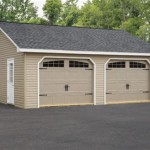How To Make A Concrete Garage Floor
A well-constructed concrete garage floor provides a durable, level surface capable of supporting heavy vehicles and equipment. This article outlines the key steps involved in creating a robust and long-lasting concrete garage floor.
Planning and Preparation
Careful planning and preparation are crucial for a successful concrete pour. This involves several key considerations:
- Obtain necessary permits: Check local building codes and obtain any required permits before starting the project.
- Calculate concrete volume: Accurately determine the volume of concrete needed based on the dimensions of the garage floor. Online calculators can assist with this task.
- Schedule concrete delivery: Arrange for concrete delivery to coincide with the completion of site preparation.
- Gather tools and materials: Assemble all necessary tools and materials, including lumber, stakes, string lines, a concrete mixer (if not using ready-mix), shovels, rakes, floats, and finishing trowels.
Site Excavation and Base Preparation
Proper site preparation ensures a stable and well-drained foundation for the concrete slab:
- Excavate the area: Excavate the area to the desired depth, typically 4-6 inches, ensuring a consistent level across the entire garage footprint.
- Compact the soil: Thoroughly compact the excavated soil using a hand tamper or mechanical compactor to create a firm base.
- Install gravel base: Add a 4-inch layer of compacted gravel to improve drainage and further stabilize the base. This layer should be level and consistent.
- Install vapor barrier: Lay a vapor barrier, such as 6-mil polyethylene sheeting, over the gravel base, overlapping seams by at least 6 inches and extending the edges up the sides of the forms.
Formwork Construction
Formwork defines the shape and thickness of the concrete slab:
- Construct forms: Build sturdy forms using 2x4 lumber, ensuring they are straight, level, and securely braced. The top edges of the forms should be level with the desired finished height of the concrete slab.
- Secure forms: Stake the forms firmly in place to prevent movement during the concrete pour.
- Apply form release agent: Apply a form release agent to the inside surfaces of the forms to prevent the concrete from sticking.
Reinforcement
Reinforcement adds strength and helps prevent cracking:
- Install wire mesh: Place wire mesh reinforcement over the vapor barrier, supported by chairs or bricks to ensure it is positioned in the middle of the slab thickness.
- Consider rebar: In areas with heavy loads or expansive soils, consider using rebar in addition to or instead of wire mesh.
Concrete Placement and Finishing
Proper concrete placement and finishing techniques are essential for a smooth, durable surface:
- Pour the concrete: Pour the concrete into the forms, starting at one corner and working systematically across the area. Consolidate the concrete with a shovel or vibrator to eliminate air pockets.
- Screed the surface: Use a screed board to level the concrete surface, working it back and forth across the forms to remove excess concrete and create a flat surface.
- Float the surface: Once the concrete has begun to set, use a bull float to further smooth the surface and embed any aggregate.
- Trowel the surface: After the bleed water has evaporated, use a steel trowel to create a smooth, hard finish. Multiple troweling passes may be necessary.
- Control joints: Cut control joints into the slab using a groover or saw to create weakened planes that control cracking. Joints should be spaced at intervals no greater than 2-3 times the slab thickness.
- Cure the concrete: Cure the concrete for at least 7 days by keeping it moist. This can be achieved by covering the slab with plastic sheeting or applying a curing compound.
Sealing the Concrete (Optional)
Applying a concrete sealer can enhance the durability and appearance of the finished floor:
- Choose a sealer: Select a sealer appropriate for garage floor applications, considering factors such as moisture resistance, chemical resistance, and desired finish.
- Apply the sealer: Apply the sealer according to the manufacturer's instructions, ensuring even coverage.

Garage Floor Coat Comprehensive Step By Guide Builds Maz

Concrete Garage Floor Demolition Setup And Pour

How To Compete With And Win Against Diy Garage Floor Kits Concrete Decor

Diy Garage Floor Coating

Diy Garage Floor Steps To

Garage Concrete Floor Slab Construction Thickness And Cost The Constructor

How To Fix A Concrete Garage Floor Diy Family Handyman

Garage Concrete Floor Slab Construction Thickness And Cost The Constructor

How To Paint A Garage Floor Clean And Scentsible

How To Pour A Garage Floor 11 Steps With Pictures Wikihow
Related Posts








